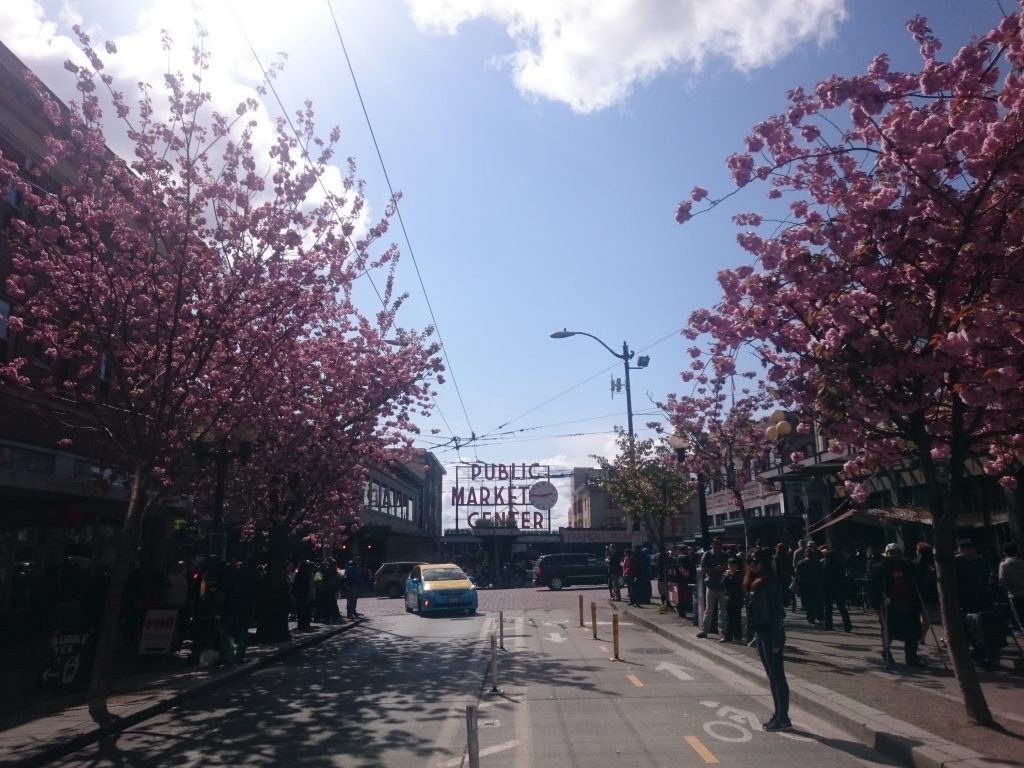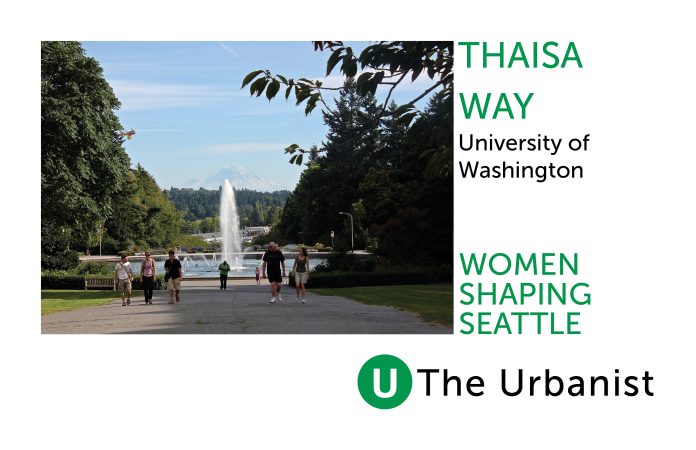Drawing on this year’s Design Festival theme of “Design Change”, is there a particular place or project that you think illuminates the way women have changed the design of Seattle?
There really is not a change that one can say has only to do with women–change is a social activity–we are all in it together. Nevertheless those with a different background ask different questions and can often see different possibilities. So yes, women can see projects in a different light given their background and they can see change with difference. Women can look at public space for example and ask questions about who uses it in ways that white men often do not consider. William Whyte’s work on public space was predominantly focused on how white men used public plazas–today students are re-investigating that research and its conclusions to consider how women, minorities, children, and others use similar spaces.
So how have women changed Seattle–architect Elizabeth Ayer and landscape architect Roberta Wightman helped to establish design in the Pacific Northwest–both building on the materials, culture, and place of our region. Ilze Jones saw architecture as a social space, as buildings that can nurture community through process as well as spatially. Jane Hastings along with women such as Carolyn Geise, Elaine Day LaTourelle, Lottie Eskilsson, Cynthia Richardson took on projects with a collaborative approach, understanding the powerful potential of bringing the right experts and knowledge to the table. These women often worked with engineers, landscape architects, and artists, both men and women. So a focus on collaboration, partnership, and collective work can be attributed to women, with men engaged, more so over time.
Women, as with other groups that are often ignored in leadership bring diversity and I don’t need to again note the essential nature of diversity when you are thinking about public spaces, cities, and urban landscapes. Diversity is paramount, in our thinking, our voices, and our futures.
I would also suggest that women have helped to keep residential work on the table as an important part of a design portfolio–not just homes and gardens for wealthy individuals but social housing, public housing, and middle class housing and landscapes–these projects are critical as homes are where we spend our time growing up and living–a life. The big awards often go to those really big, really expensive projects, although residential remains the bread and butter of many firms, women have often been willing to be more forthright about the critical contributions of domestic design to our social and cultural health and wellbeing.
Could you tell us about your work at the University of Washington and provide some insight into any projects you are currently working on?
I am a historian interested in how design has shaped our worlds, our spaces, and in particular our urban places. This is not the story of just famous people but of all the ways design, designers, and design advocates imagine, construct, use, and remember our landscapes. Think about it–most of our times is not in buildings but between, outside, in the landscape–how does that space get shaped? Why? By whom? And how does our imagination alter such spaces as different people with a remarkable diversity of backgrounds use the spaces and places? How can urban, city histories help expand our imagination by looking at the work of diverse individuals and groups? In the end my mission is to expand and enrich what we understand about our world through history.
What values, issues or interests are important to you and how do these inspire your work?
I value the role of design–primarily intentional design, when we take responsibility for what we are imagining and offering and building and finally stewarding. I value the differences that can be generated when we pay attention to who is at the table and who is in the landscape.
Design is powerful if we use it with care, engage communities, and listen listen listen and then dream, dream dream, and finally work work work…
Given your scholarship investigates feminist histories of design and the role of women as professionals and practitioners, could you provide some insight into the contribution of women to the design of Seattle?
Building on the answer to question one–there are a couple of places women have shaped–one could argue that women as shoppers are a core reason for the importance of Pike Place Market or women as designers for City Hall or as advocates with Rich Haag for Gas Works Park or as leaders for projects such as Freeway Park. As patrons, as leaders, as civically engaged individuals. In design, women such as Sharon Sutton have had the guts to challenge us to address issues of racism and sexism and violence and inequities. She and others with her have insisted the build on the powerful potential of diversity–of voices, of approaches, of backgrounds, of stories. Susan Jones has offered a voice to the need to rethink how we build, what we build with, and how we respond to human needs for shelter. Susan Bolla has been an advocate for people and place, and most specifically in rethinking how we use, draw on, and steward the built environment over time, a champion of re-habilitation and historic preservation as a dynamic practice. Ann Schopf has been a mentor to many women and men in design, pushing a focus on craft that serves people and environmental stewardship for projects in healthcare and education–two areas where design can be remarkably influential–as a catalyst and a place.

Do you consider any particular women as pioneers or innovators in the design or development of Seattle, and if so why?
I think I addressed this above–but I would add that today women in landscape architecture such as Kathryn Gustafson, Jennifer Guthrie, Shannon Nichol, Barbara Swift, Karen Kiest, and so many more are leaders in rethinking public space–how do we shape cities to nurture communities–not just today but tomorrow? How do we design for diverse communities, dynamic neighborhoods? How do we construct places that foster human and environmental health and wellbeing. The focus on public space is critical and must must must become a public priority. We live so much of our lives in public space so we must make those places generative catalysts for civic engagement.
What has been your favorite project to date or what would be your dream project?
My dream project would be making sure the waterfront is an urban landscape that becomes a catalyst for Seattle to think of itself as a city for people instead of cars. The Seattle Center re-visioning group is doing this as well–how do we envision these public landscapes into our collective futures? How do design for the future drawing on the strengths of who and where we are, ALL of us, not just the privileged few? Individuals such as Cary Moon, Julie Parrett (and her good work at the Olympic Sculpture Park), Mary Johnston, Nancy Rottle, and so many more are part of making sure we keep our eyes on the prize–a city that we can enjoy on foot, with friends, and in a thriving environment… And of course Design in Public is taking this challenge on–head first–so more power to all who are working on this–it is and will change Seattle moving us ever closer to a more resilient, fun, dynamic, and nurturing city and community.
Further information about Thaisa’s work can be found here.
Sarah is an urban planner and artist from Melbourne Australia, currently living in Seattle. She has contributed to diverse long-term projects addressing housing, transportation, community facilities, heritage and public spaces with extensive consultation with communities and other stakeholders. Her articles for The Urbanist focus on her passion for the design of sustainable, inviting and inclusive places, drawing on her research and experiences around the world.


